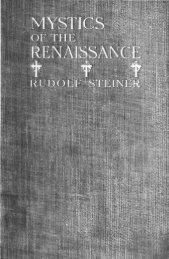The Supreme Doctrine - neo-alchemist
The Supreme Doctrine - neo-alchemist
The Supreme Doctrine - neo-alchemist
Create successful ePaper yourself
Turn your PDF publications into a flip-book with our unique Google optimized e-Paper software.
SENSATION AND SENTIMENT<br />
organism that we must modestly return in order to obtain the awakening, in<br />
its centre, of its immanent and transcendent principle.<br />
<strong>The</strong> intuitive inner regard traverses the false emotivity without stopping<br />
there; it traverses the images of the imaginary film, dispelling them as it goes.<br />
But, if it dispels this film it does not dispel the profound spasm in its actual<br />
determinism. I can already understand this theoretically: it is not enough to<br />
dispose of the imaginary film that is joined in the instant to the subconscious,<br />
in order to wipe out all this subconscious itself. And practice effectively<br />
proves to me the persistence of my profound spasm. This leads me to<br />
consider further and to understand that this spasm, which I have called<br />
abnormal (and justifiably in a sense) is on the road that leads to satori.<br />
In the spasm of my total organism there is an element of immobility<br />
which is quite certainly beneficial; our sponta<strong>neo</strong>us evolution will move<br />
towards satori if we are 'obedient to the nature of things', if we cease to busy<br />
ourselves with ersatz-forms of satori. 'To do nothing', which is the immobility<br />
of our total organism, the immobility of its phenomenal centre, allows the<br />
maturing of satori. <strong>The</strong>re is then something right and normalising in the<br />
profound spasm; it is beneficial in that it tends to immobilise our centre. If in<br />
fact it has not been normalising for me up to the present that is because I have<br />
always defended myself by means of a reflex against this immobilisation. Let<br />
us remember the double relation which exists between emotivity and the<br />
imaginary film; the images release the spasm and then the state of spasm<br />
releases images. That the images release the spasm is inevitable and is not to<br />
be regretted because that tends towards the desirable immobility. What is<br />
regrettable, and avoidable, is that the state of spasm should release images,<br />
entailing perpetual variations in the spasm, variations which prevent me from<br />
profiting by the immobility virtually contained in it. Why is a new imaginary<br />
film released by the spasm, or rather in connexion with it, preventing me<br />
from immobilising myself? Because there exists in me a false belief<br />
according to which immobility is dangerous, mortal; for lack of Faith in my<br />
Principle I still believe that I ought myself to achieve my salvation, realise by<br />
a personal activity my total accomplishment. As long as this belief operates<br />
in me I cannot prevent my state of spasm from releasing a new imaginary<br />
film, and that is a vicious circle of agitation.<br />
<strong>The</strong> caterpillar has to immobilise itself as a chrysalis in order to<br />
become a butterfly. When I am agitated in the vicious circle of emotive states<br />
and of imaginary films I am comparable with a caterpillar who feels himself<br />
143




